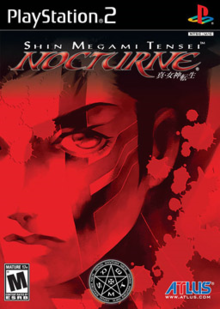| Shin Megami Tensei III: Nocturne | |
|---|---|
 North American PlayStation 2 cover art, featuring the Demi-fiend | |
| Developer(s) | Atlus |
| Publisher(s) | |
| Director(s) |
|
| Producer(s) | Kouji Okada |
| Designer(s) | Eiji Ishida |
| Artist(s) | Kazuma Kaneko |
| Writer(s) |
|
| Composer(s) |
|
| Series | Megami Tensei |
| Engine |
|
| Platform(s) | |
| Release | |
| Genre(s) | Role-playing |
| Mode(s) | Single-player |
Shin Megami Tensei III: Nocturne[a] is a role-playing video game developed by Atlus for the PlayStation 2. It was published by Atlus in Japan and North America, and by Ghostlight in Europe. It is the third numbered entry in the Shin Megami Tensei series, the central series in the Megami Tensei franchise. Multiple versions of the game have been published: the original version was published in Japan by Atlus in 2003, while a director's cut was released in 2004 in Japan. The director's cut was localized and released in North America in 2004 as Shin Megami Tensei: Nocturne and in PAL regions in 2005 as Shin Megami Tensei: Lucifer's Call. A high-definition remaster was released for the Nintendo Switch and PlayStation 4 in Japan in 2020, and was internationally released in 2021 on those consoles and Windows.
Nocturne follows a high school student in post-apocalyptic Tokyo, who is transformed into the demonic Demi-fiend after the world undergoes Conception, an apocalyptic event triggered by a sinister cult to enable the world's rebirth in a new form. With Tokyo transformed into a Vortex World filled with demons, the Demi-fiend becomes instrumental to the schemes of the Reasons, beings who seek to remake the world in their image, and Lucifer, the lord of demons. The gameplay uses a turn-based battle system based on exploiting weaknesses, and a Demon recruitment system allowing the player to recruit demons found in the Vortex World to fight alongside them.
The game was conceived after the completion of Shin Megami Tensei II and Shin Megami Tensei If..., but was delayed as the team worked out what they wanted for the game, including making it appeal to a wider audience than previous Megami Tensei games. Unlike the science fiction setting of Shin Megami Tensei II, Nocturne returned to a contemporary setting similar to the original game. The setting and characters were inspired by multiple elements, including Gnosticism, Mahayana Buddhism, and modern popular culture. Among the things the team changed from previous entries were the camera perspective, which was switched from a first- to a third-person camera perspective, and using a cel-shaded art style to distinguish it from other games of the time. The music, primarily composed by Shoji Meguro, paid homage to earlier Megami Tensei games while drawing on music styles from the 1980s.
The original edition of Nocturne released in Japan to strong sales and a positive critical reception, and the limited director's cut proved so popular that Atlus made a second print in response to fan demand. It also inspired a drama CD and light novel in Japan. The director's cut was the version chosen for localization, making Nocturne the first mainline Shin Megami Tensei game to be released in the west. The game was well received by video game publications, who praised its gameplay and atmosphere, while its challenging difficulty was often a subject of criticism and occasional praise. It was also announced to have been a commercial success in the West.
Cite error: There are <ref group=lower-alpha> tags or {{efn}} templates on this page, but the references will not show without a {{reflist|group=lower-alpha}} template or {{notelist}} template (see the help page).